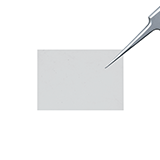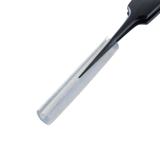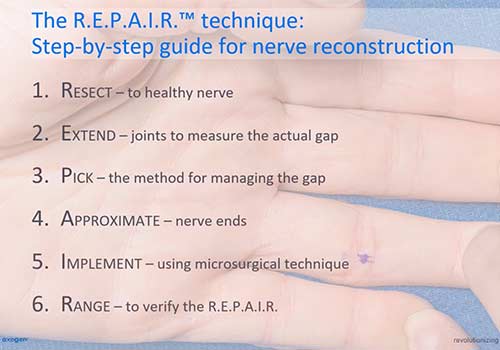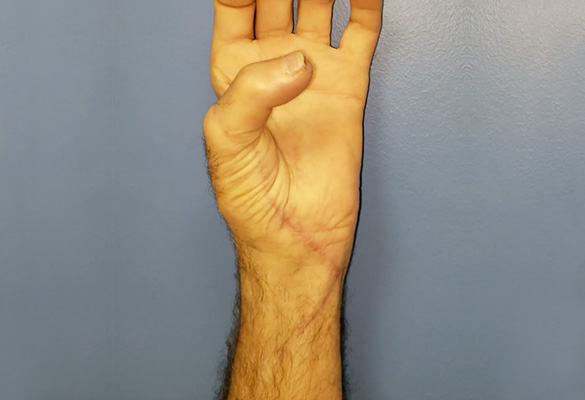trauma procedures
Surgical management for traumatic nerve injuries is complex, because they vary based on the type of nerve and degree of damage. Our technology helps ensure that neither you, nor your patients have to settle when it comes to restoring nerve function.
Although digital nerves are the most frequently injured peripheral nerves, repair results can be unpredictable due to variations in injury patterns and other patient factors. Our solutions allow you to employ bridging materials that improve consistency of results despite the variability in the situations you encounter.
Remember the following:
- If a digital nerve will not hold a single 8-0 or 9-0 suture after debridement, there is too much tension on the nerve and a bridging material will be needed.
- A review of the literature demonstrated that the number of patients reporting positive outcomes after Connector-Assisted Repair® was significantly greater than those who received suture only.1
- In gaps greater than 5 mm, conduits become less reliable. A multicenter study in digital nerve repair showed that Avance® Nerve Graft resulted in a significantly higher rate of meaningful recovery† versus conduits (88% vs. 61%).2
See how Dr. Peter Evans and Dr. Jason Nydick have developed a simple approach to mastering nerve repair.
download the brochurepublications
solutions
 Avance® Nerve Graft
Avance® Nerve Graft  Axoguard Nerve Connector®
Axoguard Nerve Connector®  Axoguard HA+ Nerve Protector™
Axoguard HA+ Nerve Protector™  Axoguard Nerve Protector® See sizing and IFU on solution pages
Axoguard Nerve Protector® See sizing and IFU on solution pages Traumatic injury to a mixed motor nerve can have a severe impact on patient quality of life due to the loss of function. Traditional nerve autograft techniques offer the chance for recovery. However, harvesting nerve tissue at a donor site can create additional problems due to functional loss, burning, tingling and numbness in another part of the body.3 With Avance Nerve Graft, you can achieve comparable results to autograft without the downsides of donor site comorbidities associated with donor tissue harvest.4
Remember the following:
- In contrast to typical autograft sources, Avance allows the surgeon to customize the bridging material in lengths up to 70 mm and diameters up to 5 mm.
- The Avance Method® optimizes the regenerative scaffold of the donor nerve and includes extensive quality controls that are currently not possible with autografts.
- Patients deserve to be informed of all reconstructive options and educated about the downsides of autograft harvest, including long-term side effects such as chronic pain and numbness.3
The patient sustained a complex laceration to his left forearm and near amputation of the left thumb from a circular saw. After reconstruction with Avance Nerve Graft he demonstrated excellent intrinsic muscle tone and opposition of his thumb confirming reinnervation of the median and ulnar nerve through the Avance Nerve Graft. Case courtesy Dr. Bauback Safa, The Buncke Clinic.
view case study Avance® Nerve Graft
Avance® Nerve Graft  Axoguard Nerve Connector®
Axoguard Nerve Connector®  Axoguard Nerve Protector® See sizing and IFU on solution pages
Axoguard Nerve Protector® See sizing and IFU on solution pages more procedures
Fill out a short form to contact a rep and get more information about our nerve repair solutions.
Sign up for our newsletter to get the latest research, news and in-depth insights about nerve repair.
references
†Defined as Medical Research Council Scale of S3/M3 or greater.
- Ducic I, et al. Refinements of nerve repair with connector-assisted coaptation. Microsurgery. Mar 2017;37(3):256-263.
- Leversedge FJ, et al. A multicenter matched cohort study of processed nerve allograft and conduit in digital nerve reconstruction. J Hand Surg Am. Dec 2020;45(12):1148-1156.
- Ducic I, et al. Chronic postoperative complications and donor site morbidity after sural nerve autograft harvest or biopsy. Microsurgery. Sep 2020;40(36):710-716.
- Safa B, et al. Peripheral nerve repair throughout the body with processed nerve allografts: Results from a large multicenter study. Microsurgery. Jul 2020;40(5):527-537.

